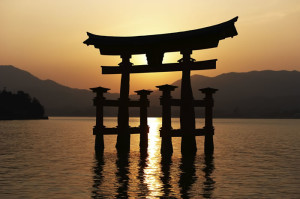Kototama Inochi Medical Philosophy
 There are many different styles of “Oriental Medicine”, Korean, Vietnamese, Japanese, Chinese, German, and French, and all are based on a principal of movement or balance of energy.
There are many different styles of “Oriental Medicine”, Korean, Vietnamese, Japanese, Chinese, German, and French, and all are based on a principal of movement or balance of energy.
Kototama Inochi Medicine is a unique, profound, and extremely effective medicine. It combines traditional Japanese acupuncture, pulse diagnosis, manual therapy, and the principles of Kototama Futomani. Masahilo Nakazono was the originator of this style of traditional Japanese medicine and spent many years studying the art of natural medicine, martial arts and the Kototama principle.
Shinto – Kototama Futomoni
Dr. Meyer’s introduction to the Kotatama principle was through the writings of the honorable Masahilo Nakazone and his teacher Sensei Koji Ogasarara, and the words of my medical teacher Dr. Thomas Duckworth, as well as many hours of private meditation.
Shinto; Shin = God or spirit or vibration, To or Do = the way
A basic conviction of Shinto is; in the beginning all creation including Gods (Kami), man, and nature are born of the same parents. This would mean all are related. According to the Kojiki (records of ancient matters), when creation came to a stage of solid matter, two Kami’s, Izanagi no Kami and Izanami no Kami, were assigned to the procreation of the entire universe including that which you can see and that which you cannot. Therefore, everything seen and unseen is Kami-born, has a Kami nature, and the potential to be fully Kami.
According to Shinto belief every living thing has a Kami or spirit. This would include man as well as animals, plants, rocks, mountains, clouds, etc. All is one with nature, one with universal law. Shinto is not a religion or a spiritual organization. It has no dogma, business plan, board of directors or congregation. Shinto is a way of being. Ancients tell of an age before the dawn of recorded time when all was one with universal law. When gods possessed human form and man looked upon the universe as vibrational form rather than modern scientific words and definitions.
As stated above, in the beginning all creation (this does not mean physical creation, rather the realization of the world of phenomenon) including Gods (spirit, vibration), man and nature are born of the same parents (place of realization). When creation came to a stage of solid matter two Kami’s Izanagi no Kami and Izanami no Kami (Izanami [yin] Izanagi [yang]) no (the), Kami (spirit) were assigned to the procreation of the entire universe. Without dualism, Yin/Yang, separation, light and shadow, phenomenon cannot be realized. If phenomenon is not realized, creation does not exist.
When we speak of the realization of phenomenon, we are not referring to how we define the world around us, rather, how the world defines its self to us. For example, our eyes do not look out over fields and streams. The vibration or Kami of the fields and streams are absorbed by our eyes and defined by our mind as shadow and color, creating an illusion of form, which we then define by creating names for each form according to our sense of the vibration itself. By accumulating many names in our memory we create language thus creating a civilization. Phenomenon can also be realized as unformed form, form that is void of color and shadow. Examples of this are philosophy, music, art, fictional stories, poetry, etc. All are realized through intuition, inspiration, and instinct, all of which form can be the result but not necessarily.
A form of meditation is daydreaming. We daydream all sorts of things, some from the memory of past events and often others from fictional events. The contents of our daydreams are unformed form, not “real” or “realized” by anyone but us. The ancient ones say that Shinto as well as Tao cannot be spoken of, only referenced. Like a daydream, Shinto and Tao are unformed form.
We realize or grasp phenomenon as it is captured by our senses (eyes, nose, ears, etc.) and held in our minds waiting for definition. How do we realize and were does realization come from? This is not our ability to realize: rather our sense of realization. Sensing is an aspect of intuition. We realize that there are mountains in the state of Colorado; however, until we are standing next to them they are not truly realized. The mountains have energy, vibration, spirit, or Kami that can only be realized in their presence. That realization is an aspect of intuition. Therefore, the realization of phenomenon is an aspect of intuition. This form of sensing is an aspect of Futomani.
Universal Law:
Universal law can be defined as balance. Universal harmony or balance is inherent in all creation. Colors in nature do not clash, sounds of nature are never off key, and branches on the North side of the tree balance those on the South. Universal law that includes human form governs natural form.
